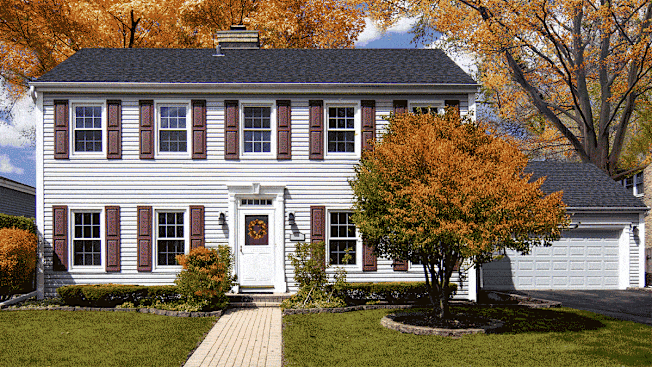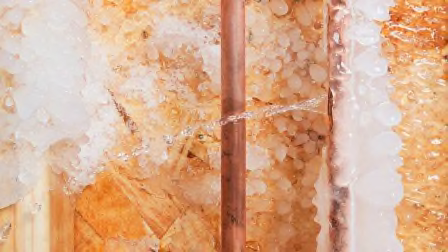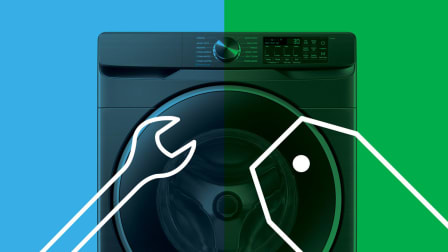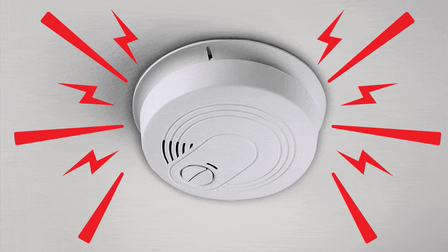10 Tips to Get Your House Ready for Winter
Projects like protecting pipes, cleaning gutters, and trimming trees now can save money and prevent hassles when the temperature drops. Here's your winter-prep hit list.

Single-digit temperatures and freezing water can wreak havoc on your house and yard. The first thing to know is that water damage—particularly damage linked to frozen and burst pipes—accounts for the lion’s share of homeowners insurance claims.
Tips for Getting Your House Ready for Winter
We’ve compiled 10 key tips for getting your house ready for winter, in order of importance.
1. Protect Indoor Pipes
“A burst pipe happens when the water inside a pipe freezes, often in the middle of the night when the temperatures get cold,” says Bo Petterson, whose "Dad Advice from Bo" account delivers home improvement and automotive advice to millions of followers on TikTok and Instagram. “The water damage that can be caused if you don’t catch it right away can also be expensive.”
According to Home Advisor, a burst pipe can cost $500 to repair and can cause up to $3,000 in additional damage. Pipe insulation, which you can install yourself around any exposed copper or PVC water pipe, costs as little as 50 cents per linear foot. Use it under sinks, in attics and crawl spaces, and on pipes along exterior walls. Pay special attention to unheated basements, where 37 percent of all burst pipes occur.
2. Insulate Your Attic
Spending money to add insulating to a poorly insulated attic will save you money in the long run. You’ll keep your home’s heat in the living quarters, where it belongs, and there’s a second benefit, too. When your attic is colder you’re much less likely to get ice dams from forming on your roof. See CR’s guide to attic insulation for detailed information on how to choose the best insulation for your situation.
3. Service Your Furnace and Chimney
Fireplaces, chimneys, and heating equipment from furnaces to portable space heaters are some of the biggest causes of home fires, according to the U.S. Fire Administration (USFA). It’s important to have your heating equipment serviced and inspected regularly. “A professional can perform a chimney sweep ahead of winter to make sure you’re in the clear,” Petterson says. Brick periodically needs upkeep to prevent water from leaking in, and the cap keeps heat-seeking animals out. Properly maintaining furnaces and boilers also keeps them working reliably and efficiently.
4. Repair Loose Roofing Shingles
“If there are any leaks from your roof, water stains on your ceiling, or an excessive amount of granules in your gutter,” you may have loose, damaged, or missing asphalt shingles, says Paolo Fu, who oversees CR’s roofing testing. Get a licensed roofing contractor to take a look, and make sure any repairs are done before winter, especially if you live in an area that gets substantial snowfalls. A cubic foot of snow can weigh 10 or 20 pounds, causing loose shingles to shift further, allowing moisture to permeate your roof. If it’s time to replace your roof, you have a number of roofing options beyond asphalt shingles, which are the most common choice. For instance metal roofing is relatively expensive to buy and install, but it can last 50 to 100 years. And it adds to the safety of homes in regions prone to wildfires.

Leaves, water, and debris can clog the gutters, which are meant to protect our home’s foundation and siding.
5. Clean and Inspect Gutters
"Leaves, water, and debris can clog the gutters, which are meant to protect our home’s foundation and siding," says Kyshawn Lane, who provides home improvement advice through his “Weekly Home Check” accounts on TikTok and Instagram. Keeping gutters clear, and making sure they aren’t coming loose from your roof, can help ensure that winter rain and melting snow runs off your roof and through downspouts. “It’s best to address this at least twice a year,” Lane says.
You can hire a local professional to check and clean your gutters—a wise choice since falls from an extension ladder can cause serious injuries. If you do the job yourself, use a ladder that extends 3 to 5 feet above your roof, and make sure it is securely planted on the ground.
6. Repair Patios and Pavers
A loose patio or paving stone will only get worse over the winter as the natural freeze and thaw cycle of the soil lifts it farther out of place in a process called “frost heave.” Have a mason or handyperson reset the loose stones in the autumn.
7. Look for Ailing Tree Limbs
A dead branch covered in ice or snow can easily snap, endangering people below and potentially causing thousands of dollars’ worth of damage. Falling limbs are also a major cause of power outages.
“If you can reach the limb safely, check for flexibility and healthy-looking wood by scraping back the bark, “ says Matt Schimmenti, who oversees CR’s chainsaw testing. “If you cannot reach the limb safely to check, it’s best to call a professional who can inspect and provide an estimate for safely removing the limbs.” Contact a properly insured and reputable tree service, landscape contractor, or arborist.
8. Secure Outdoor Water Sources
Drain and store any garden hoses or sprinklers before the first frost to eliminate the chance that they’ll freeze and burst. For hose bibs, turn off the water supply valve inside your house or basement that feeds the line, then open the outdoor spigot. Any water trapped inside will drain out. (If you don’t open the spigot, trapped water can freeze and cause a burst pipe inside.)
9. Mark Garden Beds, Paths, and Driveways
After a heavy snowfall, it can be tough to see where driveways, flower beds, or walkways end and your lawn begins. That makes it hard to clear snow—and more likely you’ll end up damaging something, especially if you or a contractor will be using a snowplow. Line the edges of those areas with fiberglass snow poles or driveway markers. (You can also check out our recent snowblower test results.)
10. Prep for Wildfire Season
It may seem contradictory to think about wildfires during the winter season, but it’s never too early to start safeguarding against disaster—especially since we’ve seen an uptick in fires over the last two years. We advise planning more than one escape route at home, keeping your smoke detectors up to date, and installing escape ladders, among other tips.
CR shares tips for hacking a too-high heating bill.
Key Questions About Winter Prep
What Temperature Should Your House Thermostat Be Set to in the Winter?
During the winter months, we recommend a setting of 68°F as a sweet spot during waking hours. If you have a programmable thermostat, you can set the temperature to drop down to 62°F overnight to save a bit on heating bills. And when you travel, you can drop the temperature all the way down to 55°F—just don’t go any lower or you’ll risk bursting a pipe.
Should You Let Fresh Air in Your House in Winter?
We found that opening your windows for as little as 5 minutes a day in the winter could improve the air quality of your home by letting out stale air and decreasing the concentration of indoor air pollutants. Cooler air also has a soothing effect on our nasal lining. That said, it’s not a necessity. If you can’t stomach the thought of cracking a window during winter, an air purifier can improve air quality without letting cold air in.
How Can You Warm Up Your House in the Winter?
If you’ve already prepared your home for winter and are looking for easy new ways to warm up, consider adding a space heater or a fireplace—even an electric fireplace insert can help.
What Are the Best Generators for Backup Power in the Winter?
A portable generator is a great way to run lights and, refrigerators, lifesaving medical equipment, and electronic devices. It won’t provide as much power as a home standby generator, but a home standby generator can cost twice as much (excluding installation, which can increase the price to nearly four times that of a portable generator). We’ve compiled a list of the best portable generators.
What Are the Best Flashlights for a Winter Power Outage?
If the lights are out, flashlights are a must-have safety item for hooking up a generator, accessing gear, or even evacuating. We’ve tried the best flashlights, which included options from Energizer and Husky.




















